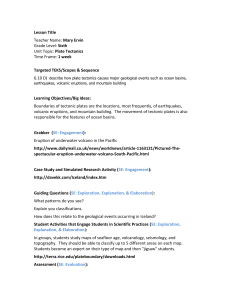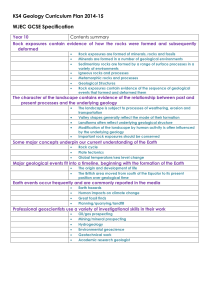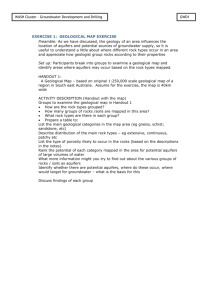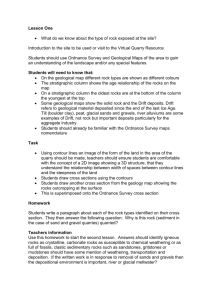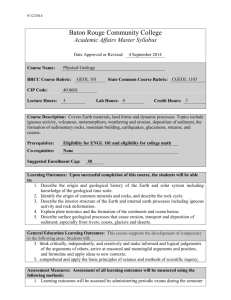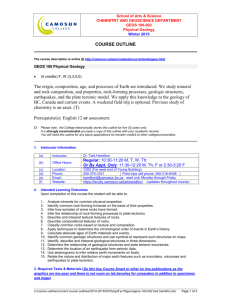Document - Université catholique de Louvain
advertisement
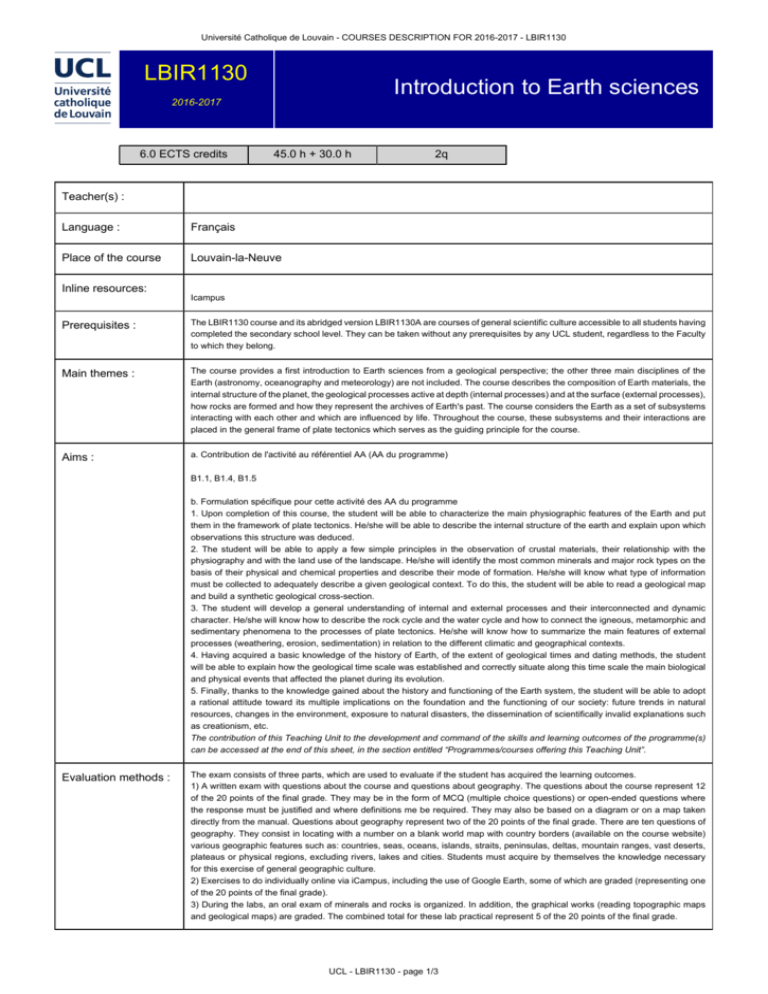
Université Catholique de Louvain - COURSES DESCRIPTION FOR 2016-2017 - LBIR1130 LBIR1130 Introduction to Earth sciences 2016-2017 6.0 ECTS credits 45.0 h + 30.0 h 2q Teacher(s) : Language : Français Place of the course Louvain-la-Neuve Inline resources: Icampus Prerequisites : The LBIR1130 course and its abridged version LBIR1130A are courses of general scientific culture accessible to all students having completed the secondary school level. They can be taken without any prerequisites by any UCL student, regardless to the Faculty to which they belong. Main themes : The course provides a first introduction to Earth sciences from a geological perspective; the other three main disciplines of the Earth (astronomy, oceanography and meteorology) are not included. The course describes the composition of Earth materials, the internal structure of the planet, the geological processes active at depth (internal processes) and at the surface (external processes), how rocks are formed and how they represent the archives of Earth's past. The course considers the Earth as a set of subsystems interacting with each other and which are influenced by life. Throughout the course, these subsystems and their interactions are placed in the general frame of plate tectonics which serves as the guiding principle for the course. Aims : a. Contribution de l'activité au référentiel AA (AA du programme) B1.1, B1.4, B1.5 b. Formulation spécifique pour cette activité des AA du programme 1. Upon completion of this course, the student will be able to characterize the main physiographic features of the Earth and put them in the framework of plate tectonics. He/she will be able to describe the internal structure of the earth and explain upon which observations this structure was deduced. 2. The student will be able to apply a few simple principles in the observation of crustal materials, their relationship with the physiography and with the land use of the landscape. He/she will identify the most common minerals and major rock types on the basis of their physical and chemical properties and describe their mode of formation. He/she will know what type of information must be collected to adequately describe a given geological context. To do this, the student will be able to read a geological map and build a synthetic geological cross-section. 3. The student will develop a general understanding of internal and external processes and their interconnected and dynamic character. He/she will know how to describe the rock cycle and the water cycle and how to connect the igneous, metamorphic and sedimentary phenomena to the processes of plate tectonics. He/she will know how to summarize the main features of external processes (weathering, erosion, sedimentation) in relation to the different climatic and geographical contexts. 4. Having acquired a basic knowledge of the history of Earth, of the extent of geological times and dating methods, the student will be able to explain how the geological time scale was established and correctly situate along this time scale the main biological and physical events that affected the planet during its evolution. 5. Finally, thanks to the knowledge gained about the history and functioning of the Earth system, the student will be able to adopt a rational attitude toward its multiple implications on the foundation and the functioning of our society: future trends in natural resources, changes in the environment, exposure to natural disasters, the dissemination of scientifically invalid explanations such as creationism, etc. The contribution of this Teaching Unit to the development and command of the skills and learning outcomes of the programme(s) can be accessed at the end of this sheet, in the section entitled “Programmes/courses offering this Teaching Unit”. Evaluation methods : The exam consists of three parts, which are used to evaluate if the student has acquired the learning outcomes. 1) A written exam with questions about the course and questions about geography. The questions about the course represent 12 of the 20 points of the final grade. They may be in the form of MCQ (multiple choice questions) or open-ended questions where the response must be justified and where definitions me be required. They may also be based on a diagram or on a map taken directly from the manual. Questions about geography represent two of the 20 points of the final grade. There are ten questions of geography. They consist in locating with a number on a blank world map with country borders (available on the course website) various geographic features such as: countries, seas, oceans, islands, straits, peninsulas, deltas, mountain ranges, vast deserts, plateaus or physical regions, excluding rivers, lakes and cities. Students must acquire by themselves the knowledge necessary for this exercise of general geographic culture. 2) Exercises to do individually online via iCampus, including the use of Google Earth, some of which are graded (representing one of the 20 points of the final grade). 3) During the labs, an oral exam of minerals and rocks is organized. In addition, the graphical works (reading topographic maps and geological maps) are graded. The combined total for these lab practical represent 5 of the 20 points of the final grade. UCL - LBIR1130 - page 1/3 Université Catholique de Louvain - COURSES DESCRIPTION FOR 2016-2017 - LBIR1130 Teaching methods : The course consists of three activities: 1. Presentations in the classroom, based on the textbook "Understanding Earth." Lectures follow the general structure of the manual and use the illustrations in it. 2. Labs of mineral and rock identification and reading of topographic and geological maps. 3. Home assignments to complete online via iCampus, including the use of Google Earth. The exercices are presented during the course and the solutions are discussed at the next course. A new assignment is proposed every two to three weeks. Content : 1. Contents The course includes the following topics: NB: The headings and numbering are those of the textbook "Understanding Earth" adopted for the course. Missing numbers correspond to chapters of the textbook that are not taught in the course. Chapter 1: The Earth System Chapter 2: Plate Tectonics: The Unifying Theory Chapter 3: Earth Materials: Minerals and Rocks Chapter 4: Igneous Rocks: Solids from Melts Chapter 5: Sedimentation: Rocks Formed by Surface Processes Chapter 8: Clocks in Rocks: Timing in the Geologic Record Chapter 9: Early History of the Terrestrial Planets Chapter 10: History of the Continents Chapter 11: Geobiology: Life Interacts with Earth Chapter 12: Volcanoes Chapter 13: Earthquakes Chapter 14: Exploring Earth's Interior Chapter 16: Weathering, Erosion and Mass Wasting: Interactions Between the Climate System and Plate Tectonic Systems Chapter 17: The Hydrologic Cycle and Groundwater Chapter 18: Stream Transport: From Mountains to Oceans Chapter 19: Winds and Deserts Chapter 21: Glaciers: The Work of Ice Complementary explanations The course is divided into two parts. The first part, during the first half of the second quadrimester, covers chapters 1, 2, 3, 4, 9, 10, 11, 12, 13 and 14. The second part, during the second half of the second quadrimester, covers chapters 5, 8, 16, 17, 18, 19, and 21. Students who wish to attend only the first part of the course as part of their minor must choose the LBIR1130A course. In this case, they are exempted from the labs. Bibliography : The course is based on the textbook "Understanding Earth" by J. Grotzinger and T. Jordan, Seventh Edition, WH Freeman & mp; Co, 2014. Acquisition of the manual is mandatory to take the course and confers the right to purchase the French translation of the manual from the DUC. This translation is incomplete and covers only the main parts of the chapters that are part of the course. Its acquisition is restricted to students who have previously acquired the complete textbook. A system of buyback of used textbooks at the end of the academic year has been set up by the DUC. PowerPoint slides shown during the class sessions are available on the iCampus website (to which registration is mandatory) to enable the student who took the course to download the slide show. Besides the succession of PowerPoint images, the iCampus website for the course contains additional documents considered as recommended reading, an introduction to the geology of Belgium, animations or software related to the course material and to the labs and references to websites of interest, including the "Understanding Earth" website which includes animations, online quizzes and flashcards for each chapter of the textbook. During the labs, a booklet containing practical criteria for identifying rocks and minerals is distributed to the students. Other infos : If a student is taking or has already completed the LBIR1130 course (or its abridged LBIR1130A version) and wants to take as optional courses another course in Earth Sciences (LGEO1251), the student's academic advisor as well as the contact teachers should be warned to establish a special program to compensate any overlap between the various topics covered by the courses or the labs. This particular program may take, for example, the form of an additional personal project. Faculty or entity in AGRO charge: UCL - LBIR1130 - page 2/3 Université Catholique de Louvain - COURSES DESCRIPTION FOR 2016-2017 - LBIR1130 Programmes / formations proposant cette unité d'enseignement (UE) Intitulé du programme Sigle Credits Prerequis Minor in Geography LGEOG100I 6 - Bachelor in Biology BIOL1BA 6 - LCUSC100I 6 - GEOG1BA 6 - ARKE2M 6 - CHIM1BA 6 - BIR1BA 6 - Minor in Scientific Culture Bachelor in Geography : General Master [120] in History of Art and Archaeology : General Bachelor in Chemistry Bachelor in Bioengineering UCL - LBIR1130 - page 3/3 Acquis d'apprentissage

